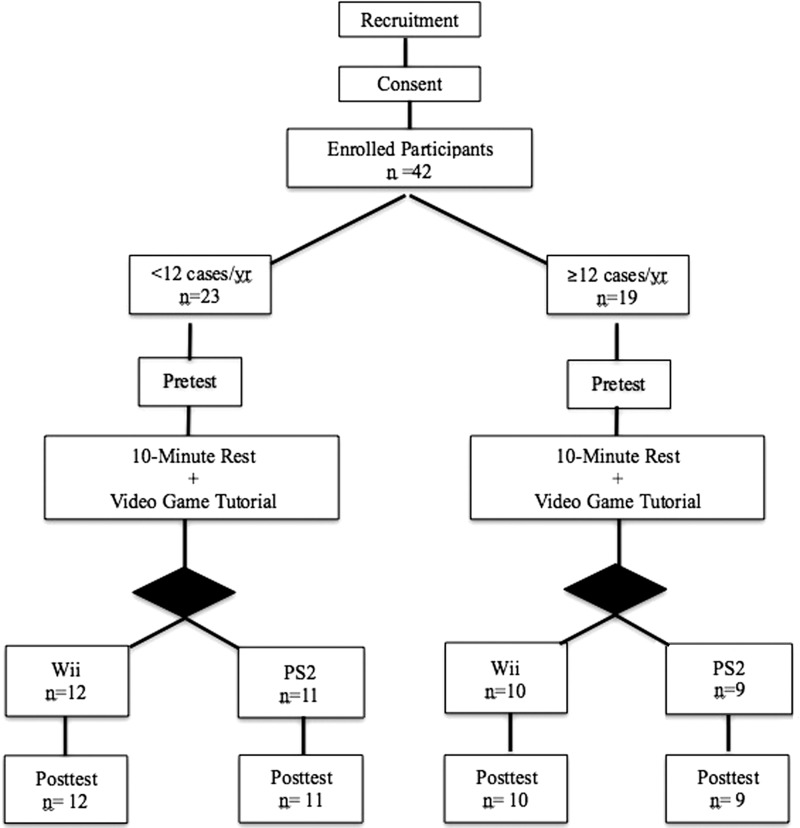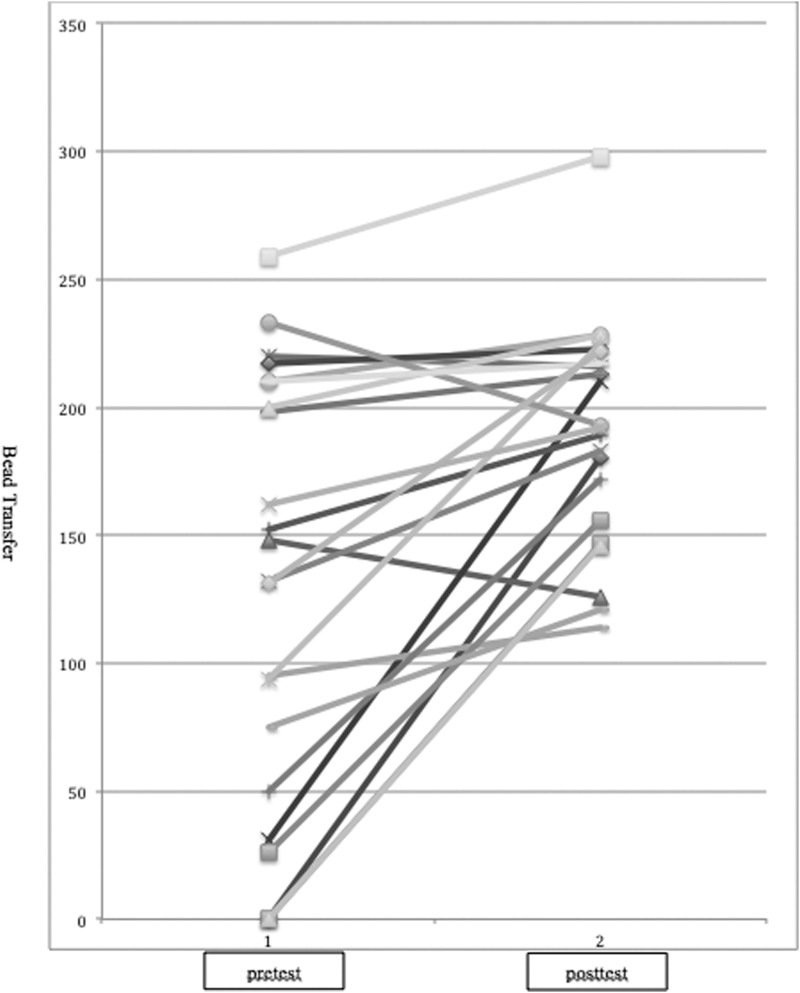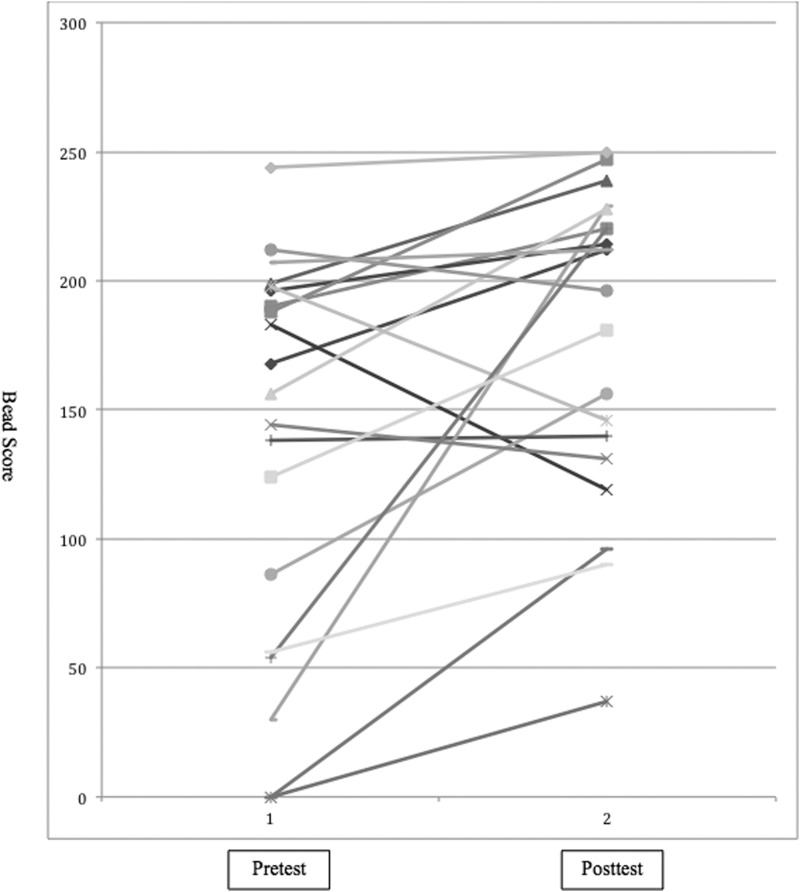The authors suggest that these video games may be an inexpensive alternative to laparoscopic training simulators.
Keywords: Laparoscopy, Video games, Surgical, Education
Abstract
Background and Objective:
The increase in laparoscopic surgery has led to a growing need to train residents in this skill. Virtual reality simulators and box trainers have been used as educational tools outside of the operating room, but both approaches have advantages and disadvantages. Video games have been an area of interest in the search for other modalities to train residents. Experience with the traditional single controller unit video games have been correlated with better surgical skill acquisition. In 2006, Nintendo introduced the Wii, a novel gaming modality that mimics movements in laparoscopy better than traditional games do. Our objective was to compare the Nintendo Wii and PlayStation2 for enhancing laparoscopy skills.
Methods:
The study included stratified randomization of 23 less experienced (<12 laparoscopy cases per year) and 19 more experienced (>12 per year) physicians, residents, and medical students to 30 min of Wii versus PlayStation2 in a university-affiliated hospital Department of Obstetrics and Gynecology. Pre- and posttest bead transfer and suturing scores were obtained.
Results:
Baseline characteristics were similar for both video game groups. Participants assigned to Wii and PlayStation2 both demonstrated significant improvement in bead transfer. Neither Wii nor PlayStation2 participants improved in suturing scores. The Wii group improved more in bead transfer scores when compared to the PlayStation2 group (60 points vs. 40 points, respectively), but this difference was not statistically significant.
Conclusions:
Both Wii and PlayStation2 significantly improved laparoscopic skills in bead transfer. These video games may be inexpensive alternatives to laparoscopy training simulators.
INTRODUCTION
The growing use of laparoscopy in gynecology has led to an increasing need for resident training.1 Virtual reality simulators and box trainers have both been used to provide a controlled setting in which residents can develop technical skills outside of the operating room.2–4 Several studies have demonstrated a strong correlation between performance on a virtual reality simulator and performance in the operating room.5,6 Virtual reality simulators display high-fidelity images and scenarios, but one major disadvantage is the paucity of tissue feedback or haptics. On the other hand, the low-fidelity, low-budget box trainers provide tactile feedback. Students trained on box trainers have also shown significant improvement in their intra- and extracorporeal suture-tying skills, precision, and overall surgical time, compared with the controls.7 Residents may have better skill retention after training with a box trainer.8
The debut of the Nintendo Wii in 2006 introduced the world to a novel gaming experience; 3-dimensional movement mimicry and tactile feedback. Wii controllers consist of a Wii Remote paired with a Wii Nunchuk. This duo functions on accelerator technology and triangulation, thus allowing for much more realistic movements than traditional controllers. Accelerators are a vector-based technology that can sense orientation and shock to provide feedback vibration. They allow the player to move freely and mimic true motion. Players grasp the controllers and move their arms, hands, and wrists. Many Wii games involve fine motor skills and precise coordinated maneuvers of the controllers, which more accurately mimic movements in laparoscopy. They necessitate timing, depth perception, quick reflexes, and precise movements. At the end of each game, the console scores the performance.
Studies on the correlation between manual dexterity, speed, and acquisition of laparoscopic skills with video game experience are conflicting.9–12 Several recent studies have focused on the Wii platform. Similar to traditional video games, Wii has been found to be associated with better laparoscopy skill.13 We hypothesized that the Nintendo Wii would be superior to traditional joystick/push button video games such as PlayStation2 (PS2) for laparoscopy training.
METHODS
This was a single-center, stratified, randomized, controlled trial conducted at the Beth Israel Medical Center in New York City. Randomization was done using balanced randomization (1:1) in blocks of 10. Allocation concealment was maintained by central randomization until after the pretest was completed. A sample size of convenience was used. Eligible participants were Department of Obstetrics and Gynecology house staff and faculty as well as third- and fourth-year medical students. Recruitment was performed via E-mail and during grand rounds. Testing was performed during daylight hours whenever a participant had an uninterrupted block of time during the workday or immediately afterwards. No testing was done post call or in the middle of the night. The trial was approved by the Beth Israel Medical Center Institutional Review Board. The trial is registered: ClinicalTrials.gov Identifier: NCT01483677.
A background questionnaire gathered demographics, experience in laparoscopy, and video games. A stratified enrollment by the number of laparoscopy cases performed in the past year was conducted. This categorization was used to take into account the range of laparoscopy experience from intern to chiefs, and within the attending pool. An intern may not have more cases than a medical student, and a chief may have had a similar number of cases as certain attendings in the past year. Each stratum was then randomized to either the Nintendo Wii or PlayStation2. All test participants completed a box trainer pretest after watching a short instructional video where an American Association of Gynecologic Laparoscopists fellowship trained Minimally Invasive Gynecology Specialist (Dr. Wang) demonstrated the box trainer task. After a 10-min break, during which they watched a short video tutorial on the assigned video game, they played their respective video games for 30 min. Upon completion of the game, the participants received a 10-min break before taking the post-test. The post-test was identical to the pretest (Figure 1). The first author conducted all proctoring.
Figure 1.
Study design.
Box Trainer Pretest and Posttest
The optical system comprised a camera, a light source, a monitor and a zero-degree 10-mm laparoscope secured at a fixed angle and distance directed away from the participant. The image was projected onto the monitor placed in line with the participant. The 2 tasks were intracorporeal suturing and bead transfer.
Suturing Task
Two tourniquets were spaced 0.5 cm apart and secured to a base. Mirrored targets were marked on the tourniquets at 1.5-cm intervals and 0.5 cm from the edge. The goal was to place 3 interrupted stitches using polyglactin suture and secure them with intracorporeal square knots. Accuracy was measured by the distance between the suture and the premarked targets. An error was defined as a gap >2 mm. Points were deducted for sutures placed more than 2 mm from the premarked targets. The quality of the knot was evaluated by attempting to insert a small suture scissor under the knot. If it passed, the knot was considered to be loose or unsatisfactory and thus was not included in the final score. Five minutes were allotted to the task. The score was produced by counting the number of secure knots made in 5 min and subtracting any errors with regards to accuracy and loose knots.
Bead Transfer Task
Two pegs were secured on the left and right sides of a board. Three beads were stacked on the left peg. The task was to grasp each bead with the right grasper, transfer it to the left grasper in midair and then stack it on the right peg. After all 3 beads had been transferred onto the right peg, they were then transferred back to the left peg in a similar fashion. Five minutes were allowed for the task. The time to completion was subtracted from a starting score of 300 (seconds). Each bead not on a peg at the end of the task incurred a 20-point deduction.
Video Games
PlayStation2 Trial (Time Crisis 2)
The participants received a scripted video introduction to the PlayStation2 system (Sony Playstation 2 Model No: SCPH-30001 Serial Number: U0288336. Sony Computer Entertainment America LLC: 919 & 989 East Hillsdale Boulevard, Foster City CA, 94404,650 655 8000), controllers, goals, and rules of the game. Time Crisis 2 was the game played on PlayStation2. The purpose of this game was to shoot as many enemies as possible in a set period of time. Participants played as many times as possible in a 30-min time span.
Nintendo Wii Trial (Boomblox)
The participants received a scripted video introduction to the Wii system (Nintendo Wii Model No. RVL-001, Serial Number: LU304728242 Nintendo of America Inc., P.O. Box 957, Redmond, WA 98073-0957 USA), controllers, goals, and rules of the game. Boomblox was the game played on the Wii. The goal was to remove as many blocks as possible in a steady and controlled fashion. Participants played as many times as possible in a 30-min time span.
Data Analysis
Final Wii and PS2 scores were compiled by averaging all scores from the 30 min of game play. Paired t tests were used to analyze mean and standard deviations of the pre- and post-test scores. This study was reported using the 2010 CONSORT guidelines.14
RESULTS
A total of 42 (Wii: 22, PS2: 20) participants were enrolled. Demographic characteristics, video game experience, and laparoscopic experience were similar in the 2 groups (Table 1). Twenty-three participants had fewer than 12 cases per year, and 19 had more. The Wii group consisted of 12 less-experienced and 10 more-experienced surgeons. The PS2 group consisted of 11 less-experienced and 9 more-experienced surgeons. Participants included third-year medical students, fourth-year medical students, Obstetrics & Gynecology attending physicians and residents PGY 1-4.
Table 1.
Demographic Characteristics of Participants by Game Assignment
| Wii (%) | PS2 (%) | |
|---|---|---|
| Sex | ||
| Female | 59 | 70 |
| Male | 41 | 30 |
| Age (yrs) | ||
| <30 | 32 | 45 |
| 31–40 | 41 | 25 |
| >40 | 27 | 30 |
| Experience | ||
| <12 cases/year | 55 | 55 |
| ≥12 cases/year | 45 | 45 |
| Hand Dominance | ||
| Right | 86 | 100 |
| Left | 5 | 0 |
| Ambidextrous | 9 | 0 |
| Video Game History | ||
| Never | 14 | 10 |
| Past | 64 | 60 |
| Present | 22 | 30 |
| Past Gaming Hours (per week) | ||
| N/A | 22 | 15 |
| <1 | 50 | 30 |
| 1–2 | 18 | 35 |
| 3–4 | 5 | 10 |
| >4 | 5 | 10 |
| Current Gaming Hours (per week) | ||
| <1 | 40 | 66 |
| 1–2 | 20 | 17 |
| 3–4 | 0 | 17 |
| >4 | 40 | 0 |
All participants assigned to Wii showed significant improvement in bead-transfer scores (pretest 129±18 vs. post-test 191±9, P<.001). Of this intervention group, 86% performed better, and 14% performed worse on their post-test bead task. No statistically significant improvement in suturing scores (pretest 0.45±0.14 vs. post-test 0.59±0.17) (Table 2) was observed. In fact, 18% performed worse, 64% the same, and 18% better on their suturing task (Figure 2).
Table 2.
Box Trainer Scores by Game Assignment
| Beads | Wii (n=22) Mean±SD | P | PS2 (n=20) Mean±SD | P |
|---|---|---|---|---|
| Pretest | 129±18 | 139±17 | ||
| Post-test | 191±9 | 178±14 | ||
| Score change | 62±14 | <.001 | 40±14 | .012 |
| Suture | Wii (n=22) Mean±SD | PS2 (n=20) Mean±SD | ||
|---|---|---|---|---|
| Pretest | 0.45±0.14 | 0.45±0.18 | ||
| Post-test | 0.59±0.17 | 0.55±0.2 | ||
| Score change | 0.14±0.19 | .48 | 0.1±0.18 | .58 |
Figure 2.
Bead transfer pretest vs. posttest for Wii.
PS2 participants also showed statistically significant improvement in bead-transfer scores (pretest 139±17 vs. post-test 178±14, P = .012). Eighty percent performed better, and 20% performed worse on their post-test bead task. Suturing scores were not significantly improved (pretest 0.45±0.18 vs. post-test 0.55±0.20) (Table 2). Fifteen percent performed worse, 55% the same, and 30% better on their suturing task (Figure 3).
Figure 3.
Bead transfer pretest vs. posttest for PS2.
DISCUSSION
Laparoscopic bead transfer skills were significantly improved in both Wii and PS2 participants. Although the degree of improvement between the 2 cohorts was not statistically significant despite a large difference (Wii: 62±14, PS2: 40±14), this pilot study was not powered to detect a difference of this magnitude. However, the difference of 22 points or seconds on the bead transfer task is encouraging and may carry clinical importance.
Several studies have focused on examining the impact of Wii gaming with laparoscopy performance. These investigations compared intervention with the Wii versus no intervention. Badurdeen et al.13 found that participants with previous Wii experience demonstrated higher baseline laparoscopic skills. Boyle et al.15 noted improved bead transfer skills after practicing on the Wii (Super Monkey Balls) for 3 h over the span of 7 d. A study by Schilkum et al.16 found Wii players to move more proficiently in laparoscopy than nonplayers did. To our knowledge, no study has compared the impact of Wii versus traditional video games on laparoscopic skill improvement. This study is unique in its attempt to identify any advantage derived from the tactile feedback and novel Wii mechanics that mimic laparoscopic movements better than traditional joystick/pushbutton systems.
We noticed a decline in the bead transfer box trainer score after the intervention in Wii and PS2 participants (14% and 20%, respectively). This paradoxical outcome can be attributed to participant fatigue and distraction. The study was conducted in the call room lounge. Foot traffic and telephone calls in this area were unavoidable. We tried to minimize distraction by keeping the door closed and asking those who passed through to keep noise to a minimum.
This study had both strengths and weaknesses. The strengths include clear, specific, and measurable outcomes, high participation rate, and no loss to follow-up. The weaknesses include using a sample size of convenience, limited duration of exposure, limited follow-up, and a single proctor who also performed the randomization. A single 30-min episode of video game time may not have been enough exposure to detect a real difference on the impact of Wii versus PS2 on long-term laparoscopic skills over the course of residency training.
CONCLUSION
Both the Wii and PS2 significantly improved laparoscopic skills in bead transfer as a training tool and may serve as a low-cost alternative to expensive simulators.
Contributor Information
Rujin Ju, Department of Obstetrics and Gynecology, The University of North Carolina: Chapel Hill, UNC Hospitals, Chapel Hill, NC, USA..
Peter L. Chang, Department of Obstetrics and Gynecology, Beth Israel Medical Center, Baird Hall, NY, New York, USA..
Adam P. Buckley, Department of Obstetrics and Gynecology, Beth Israel Medical Center, Baird Hall, NY, New York, USA..
Karen C. Wang, Department of Obstetrics and Gynecology, Brigham and Women's Hospital, Boston, MA, USA..
References:
- 1. Brummer TH, Seppala TT, Harkki PS. National learning curve for laparoscopic hysterectomy and trends in hysterectomy in Finland 2000–2005. Hum Reprod. 2008;23(4):840–845 [DOI] [PubMed] [Google Scholar]
- 2. Munz Y, Kumar BD, Moorthy K, Bann S, Darzi A. Laparoscopic virtual reality and box trainers: is one superior to the other? Surg Endosc. 2004;18(3):485–494 [DOI] [PubMed] [Google Scholar]
- 3. Mohammadi Y, Lerner MA, Sethi AS, Sundaram CP. Comparison of laparoscopy training using the box trainer versus the virtual trainer. JSLS. 2010;14(2):205–212 [DOI] [PMC free article] [PubMed] [Google Scholar]
- 4. Lewis TM, Aggarwal R, Rajaretnam N, Grantcharov TP, Darzi A. Training in surgical oncology - The role of VR simulation. Surg Oncol. 2011;20(3):134–139 [DOI] [PubMed] [Google Scholar]
- 5. Banks EH, Chudnoff S, Karmin I, Wang C, Pardanani S. Does a surgical simulator improve resident operative performance of laparoscopic tubal ligation? Am J Obstet Gynecol. 2007;197(5):541 e541–545 [DOI] [PubMed] [Google Scholar]
- 6. Newmark J, Dandolu V, Milner R, Grewal H, Harbison S, Hernandez E. Correlating virtual reality and box trainer tasks in the assessment of laparoscopic surgical skills. Am J Obstet Gynecol. 2007;197(5):546 e541–e544 [DOI] [PubMed] [Google Scholar]
- 7. Fried GM, Feldman LS, Vassiliou MC, et al. Proving the value of simulation in laparoscopic surgery. Ann Surg. 240(3):518–525, 2004; discussion 525–518 [DOI] [PMC free article] [PubMed] [Google Scholar]
- 8. Stefanidis D, Korndorffer JR, Jr., Sierra R, Touchard C, Dunne JB, Scott DJ. Skill retention following proficiency-based laparoscopic simulator training. Surgery. 2005;138(2):165–170 [DOI] [PubMed] [Google Scholar]
- 9. Rosser JC, Jr., Lynch PJ, Cuddihy L, Gentile DA, Klonsky J, Merrell R. The impact of video games on training surgeons in the 21st century. Arch Surg. 2007;142(2):181–186; discusssion 186 [DOI] [PubMed] [Google Scholar]
- 10. Grantcharov TP, Bardram L, Funch-Jensen P, Rosenberg J. Impact of hand dominance, gender, and experience with computer games on performance in virtual reality laparoscopy. Surg Endosc. 2003;17(7):1082–1085 [DOI] [PubMed] [Google Scholar]
- 11. Van Hove C, Perry KA, Spight DH, et al. Predictors of technical skill acquisition among resident trainees in a laparoscopic skills education program. World J Surg. 2008;32(9):1917–1921 [DOI] [PubMed] [Google Scholar]
- 12. van Dongen KW, Verleisdonk EJ, Schijven MP, Broeders IA. Will the Playstation generation become better endoscopic surgeons? Surg Endosc. 2011;25(7):2275–2280 [DOI] [PMC free article] [PubMed] [Google Scholar]
- 13. Badurdeen S, Abdul-Samad O, Story G, Wilson C, Down S, Harris A. Nintendo Wii video-gaming ability predicts laparoscopic skill. Surg Endosc. 2010;24(8):1824–1828 [DOI] [PubMed] [Google Scholar]
- 14. Schulz KF, Altman DG, Moher D. CONSORT 2010 statement: updated guidelines for reporting parallel group randomised trials. Int J Surg. 2011;9(8):672–677 [DOI] [PubMed] [Google Scholar]
- 15. Boyle E, Kennedy AM, Traynor O, Hill AD. Training surgical skills using nonsurgical tasks–can Nintendo Wii improve surgical performance? J Surg Ed. 2011;68(2):148–154 [DOI] [PubMed] [Google Scholar]
- 16. Bokhari R, Bollman-McGregor J, Kahoi K, Smith M, Feinstein A, Ferrara J. Design, development, and validation of a take-home simulator for fundamental laparoscopic skills: using Nintendo Wii for surgical training. Am Surgeon. 2010;76(6):583–586 [DOI] [PubMed] [Google Scholar]





